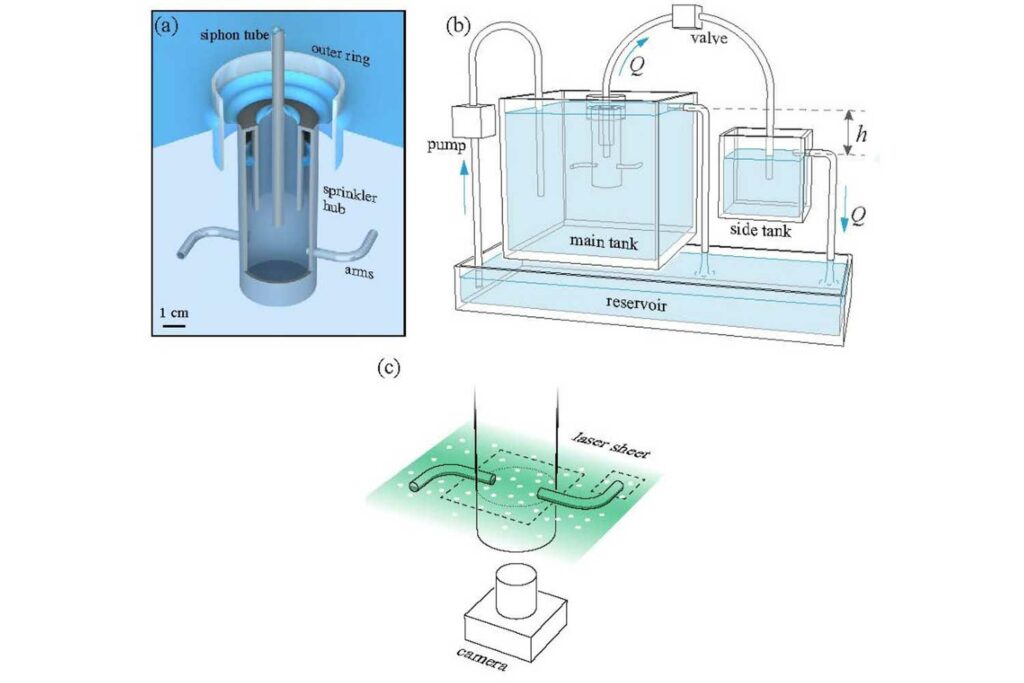The Feynman sprinkler problem is often presented as a thought experiment involving a specific type of lawn sprinkler. In this scenario, the sprinkler spins when fluid, like water, is expelled from its S-shaped tubes or “arms.” The thought experiment poses the question of what happens when fluid is instead drawn into the arms: Does the device rotate, in which direction, and why?
This problem has deep historical roots and is associated with prominent figures in physics, starting with Ernst Mach in the 1880s and later popularized by Nobel laureate Richard Feynman from the 1960s to the 1980s. Despite decades of exploration, the question has remained open. It continues to be a subject of debate and study in physics and fluid mechanics, making it a persistent challenge and an intriguing topic in scientific literature and textbooks.
For many years, scientists have been intrigued by Feynman’s Sprinkler Problem, which involves understanding how a sprinkler operates in reverse—meaning water flows into the device instead of out. A team of mathematicians has finally unraveled this mystery through precise laboratory experiments and mathematical modeling.
The study reveals that a reverse sprinkler rotates in the opposite direction when taking in water compared to when it expels water, and the explanation behind this phenomenon is both subtle and surprising.
The researchers employed a combination of hands-on experiments and mathematical analysis to shed light on the intricacies of how flowing fluids exert forces and move structures, ultimately solving the long-standing puzzle of the reverse sprinkler.
Leif Ristroph, an associate professor at New York University‘s Courant Institute of Mathematical Sciences, said, “The regular or ‘forward’ sprinkler is similar to a rocket since it propels itself by shooting out jets. But the reverse sprinkler is mysterious since the water being sucked in doesn’t look at all like jets. We discovered that the secret is hidden inside the sprinkler, where there are indeed jets that explain the observed motions.”
The research successfully addresses one of the oldest and most challenging problems in the physics of fluids. Though acknowledging that understanding the workings of a reverse sprinkler may have limited practical applications, Ristroph and the research team have significantly contributed to the fundamental understanding of fluid dynamics.
Ristroph said, “There is no need to ‘unwater’ lawn- the findings teach us about the underlying physics and whether we can improve the methods needed to engineer devices that use flowing fluids to control motions and forces.”
Brennan Sprinkle, an assistant professor at Colorado School of Mines and one of the paper’s co-authors, said, “We now have a much better understanding about situations in which fluid flow through structures can induce motion. We think these methods we used in our experiments will be useful for many practical applications involving devices that respond to flowing air or water.”
In conducting the study, researchers created custom-made sprinkler devices and submerged them in water within a setup that allowed for controlled inflow or outflow of water. To facilitate unrestricted spinning of the device in response to the water flow, the researchers developed an innovative ultra-low-friction rotary bearing. Additionally, the design of the sprinkler was carefully crafted to enable the researchers to observe and measure the water’s flow both outside and inside the device.

Ristroph explains, “This has never been done before and was key to solving the problem.”
To better understand the reverse sprinkler process, the researchers enhanced their observations by introducing dyes and microparticles into the water. They illuminated the mixture with lasers and used high-speed cameras to capture the intricate flows.
The results revealed that a reverse sprinkler rotates significantly slower than a traditional one—approximately 50 times slower. However, the underlying mechanisms are fundamentally similar. In a standard forward sprinkler, the action resembles a rotating water-powered rocket expelling jets from its arms.
In contrast, a reverse sprinkler behaves like an “inside-out rocket,” with jets directed inside the chamber where the arms converge. The researchers observed that the two internal jets collide but not directly head-on. Their mathematical model illustrated how this subtle collision effect generates forces that cause the sprinkler to rotate in reverse.
Ristroph said, “The team sees the breakthrough as potentially beneficial to harnessing climate-friendly energy sources.”
“There are ample and sustainable sources of energy flowing around us—wind in our atmosphere as well as waves and currents in our oceans and rivers. Figuring out how to harvest this energy is a major challenge and will require us to better understand the physics of fluids.”
Journal Reference:
- Kaizhe Wang, Brennan Sprinkle, Mingxuan Zuo, and Leif Ristroph. Centrifugal Flows Drive Reverse Rotation of Feynman’s Sprinkler. Physical Review Letters. DOI: 10.1103/PhysRevLett.132.044003
